The Intel SSD 330 Review (60GB, 120GB, 180GB)
by Anand Lal Shimpi on August 1, 2012 12:01 AM ESTThe Test
| CPU | Intel Core i7 2600K running at 3.4GHz (Turbo & EIST Disabled) - for AT SB 2011, AS SSD & ATTO |
| Motherboard: | Intel DH67BL Motherboard |
| Chipset: | Intel H67 |
| Chipset Drivers: | Intel 9.1.1.1015 + Intel RST 10.2 |
| Memory: | Corsair Vengeance DDR3-1333 2 x 2GB (7-7-7-20) |
| Video Card: | eVGA GeForce GTX 285 |
| Video Drivers: | NVIDIA ForceWare 190.38 64-bit |
| Desktop Resolution: | 1920 x 1200 |
| OS: | Windows 7 x64 |
Random Read/Write Speed
The four corners of SSD performance are as follows: random read, random write, sequential read and sequential write speed. Random accesses are generally small in size, while sequential accesses tend to be larger and thus we have the four Iometer tests we use in all of our reviews.
Our first test writes 4KB in a completely random pattern over an 8GB space of the drive to simulate the sort of random access that you'd see on an OS drive (even this is more stressful than a normal desktop user would see). I perform three concurrent IOs and run the test for 3 minutes. The results reported are in average MB/s over the entire time. We use both standard pseudo randomly generated data for each write as well as fully random data to show you both the maximum and minimum performance offered by SandForce based drives in these tests. The average performance of SF drives will likely be somewhere in between the two values for each drive you see in the graphs. For an understanding of why this matters, read our original SandForce article.
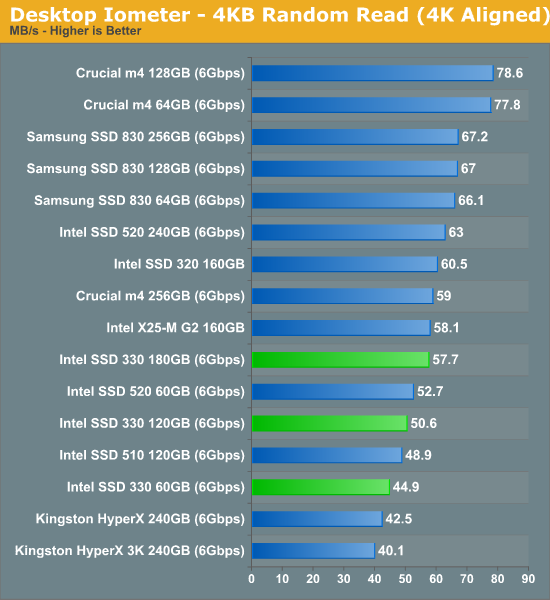
At similar capacities, the 330 and 520 offer nearly identical random read performance. The old X25-M G2 actually offers better random read performance than many of the newer drives, although most users would be hard pressed to tell the difference in actual usage.
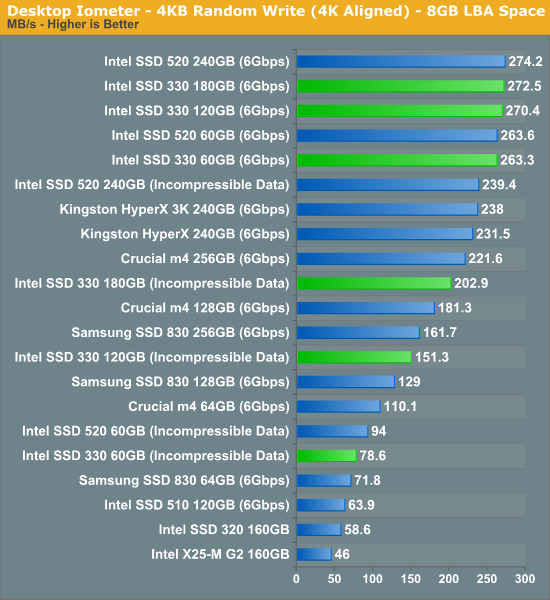
Random write performance is great with easily compressible data, but even when faced with data that can't be reduced the Intel SSD 330 does very well. Once again performance is very similar between the 330 and 520 drives.
Many of you have asked for random write performance at higher queue depths. What I have below is our 4KB random write test performed at a queue depth of 32 instead of 3. While the vast majority of desktop usage models experience queue depths of 0 - 5, higher depths are possible in heavy I/O (and multi-user) workloads:
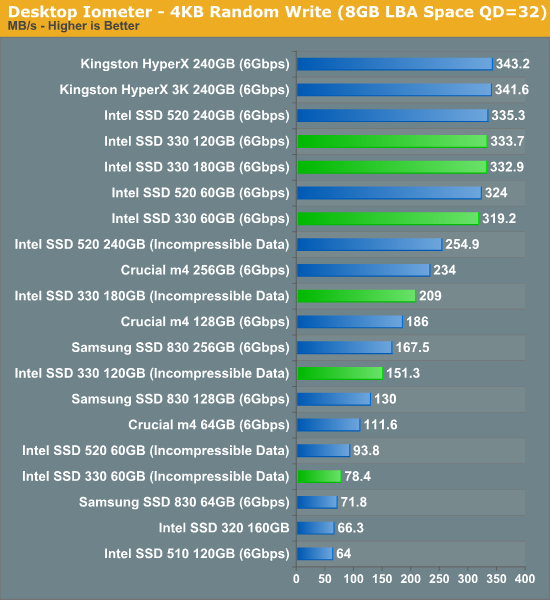
Sequential Read/Write Speed
To measure sequential performance I ran a 1 minute long 128KB sequential test over the entire span of the drive at a queue depth of 1. The results reported are in average MB/s over the entire test length.
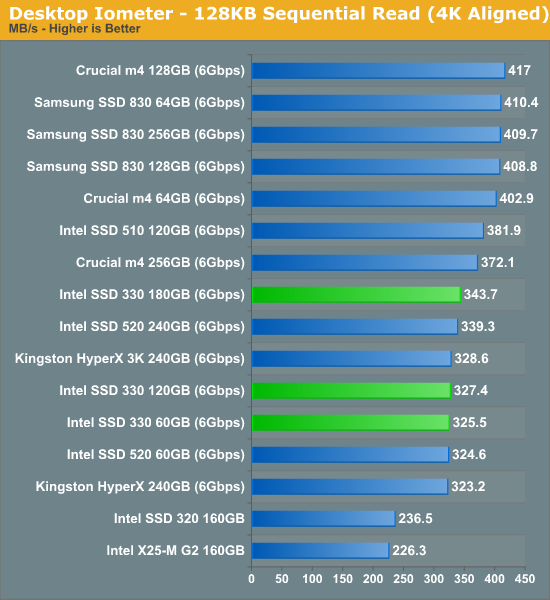
Low queue depth sequential read performance is good but not exactly class leading. Once again there's no real performance difference between the 330 and 520.
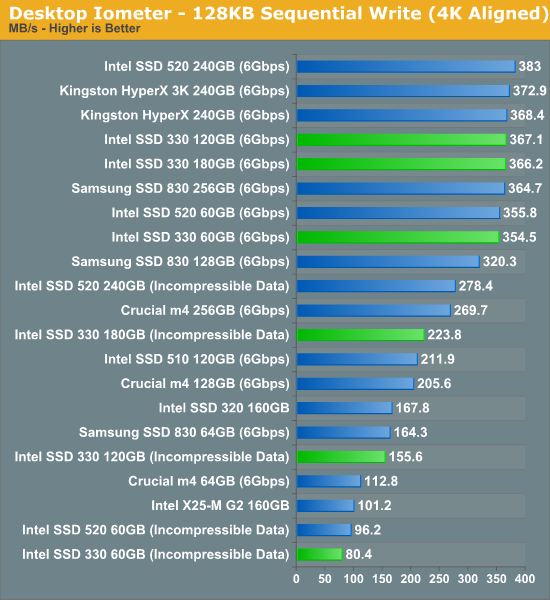
Sequential write performance with incompressible data is the biggest downside to any SandForce based drive. Try copying a compressed video or photos to the drive and you'll get speeds south of 230MB/s. The 60GB drive can only manage 80MB/s with incompressible data, that's actually no faster than the old Intel X25-M.
AS-SSD Incompressible Sequential Performance
The AS-SSD sequential benchmark uses incompressible data for all of its transfers. The result is a pretty big reduction in sequential write speed on SandForce based controllers.

Here we see what higher queue depth sequential reads look like. The 330 gets close to 500MB/s but never actually exceeds it.
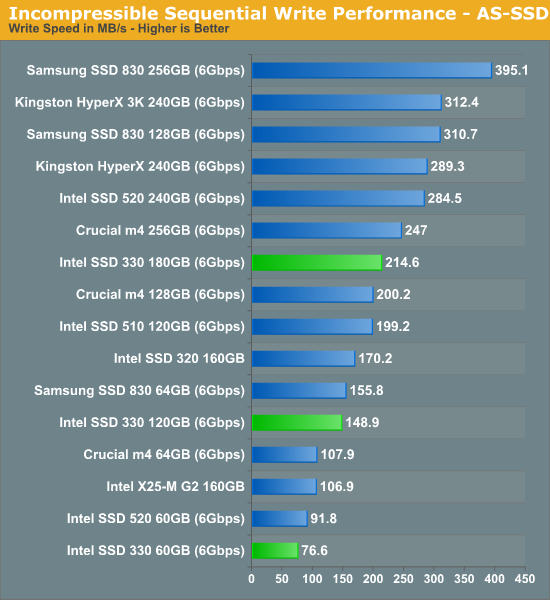
Incompressible sequential write performance, again, doesn't look very good.










64 Comments
View All Comments
Kristian Vättö - Thursday, August 2, 2012 - link
Check back tomorrow ;-)antef - Wednesday, August 1, 2012 - link
Buy buy buy! Even less than what Anand's chart show. What a deal.bim27142 - Wednesday, August 1, 2012 - link
I am really torn between Samsung 830 128GB and Intel 330 180GB...I am just a typical user and a casual gamer... I've read good reviews about Samsung's performance at since it's not Sandforce based...
Capacity-wise, I really find the Intel 180GB just right enough for me... So I am really torn which one is better for my case... :(
mailrachit - Monday, August 13, 2012 - link
As 'a typical user and casual gamer' myself I was asking the same question Samsung 830 128 GB or Intel 330 180 GB just two months ago when I was making a new ivy bridge desktop rig.I went with Intel 330 180 GB and I must say that I am quite happy with my decision.
The performance is stellar. I trust Intel for reliability and God knows I need the extra space (180 GB - 128 GB).
Look for deals and you can get the Intel one for real cheap (I got it for $110).
angelsmaster - Tuesday, September 4, 2012 - link
hi, i just also bought the 330 series but now, its 240 gb.. did you update the firmware,, cause i cant seem to find one for th 240gb. i know its the same as 180gb model. but i can't seem to make the link work. btw. iam using macbook pro 15" 2011. thank...SewerSoldier - Thursday, August 2, 2012 - link
Hi,I'm currently looking at buying a 120/128GB system/application SSD for use beside a 1TB HDD for media.
I'm deciding between Samsung 830 Series and Intel 330. However in my country the samsung costs 130€ and the intel 112€.
My question is if I'm right in assuming that Intel 330 is the better choice since the better performance of the samsung with incompressible data isn't really important for a system/application drive?
softdrinkviking - Friday, August 3, 2012 - link
disappointed that intel hasn't come back with a new controller of their own. I own and love a 34nm intel drive, and I love how reliable it has been.it seems like intel can really put out good stuff when they put enough R&D into it, but I am not sure about their track record when working with other companies on tech. (like sandforce)
Per Hansson - Saturday, August 4, 2012 - link
Well honestly there have been reports of the "8MB bug" happening even with the latest firmware on the Intel 320 drive so I would not be so sure about that...http://communities.intel.com/thread/24339
http://communities.intel.com/message/162330
http://communities.intel.com/message/161880
softdrinkviking - Saturday, August 4, 2012 - link
Oh yeah, I forgot about that whole fiasco. Still, there is something I don't like about relying on data compression technology to speed up a drive. The potential for catastrophic data loss seems to be higher if you are dealing with multiple levels of logic abstraction. For similar reasons, I never used those drive doubler technologies that were popular before traditional HDDs became so big.Thinking about it from a data recovery point of view, how would this effect the difficulty and cost of recovering data from a drive?
I know the whole recovery process would be totally different from a HDD, but it still could be a consideration.
booomups - Thursday, August 30, 2012 - link
i really wonder about this, since it seems strange if intel says on some drives it does and in others it doesn make sense. in the review it says its enabled for the 180gb version, and not for the 120gb version. how certain is that even in newer drives revisions?and... intel doesnt mention e aes encryption for the 330 drives, but it is a big point for the 520 drives.
any details on that, ita the same chip after all.